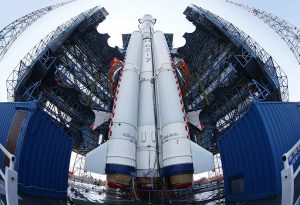Their space program may still be young compared to other countries, but China just announced they’re building a rocket that could get an astronaut to the moon.
The China National Space Administration (CNSA) said it’s developing a manned spacecraft that can fly both low-Earth orbits and take people to our lunar neighbor, according to the Associated Press. The state-run newspaper Science and Technology Daily quoted one spaceship engineer Zhang Bainian as saying the new spacecraft would have room for multiple astronauts and would be recoverable. He didn’t go into detail about the design but did compare it to the Orion spacecraft currently being developed by NASA and the European Space Agency.
In a previous statement, China said they plan to get an astronaut to the moon by the mid-2030s although the announcement came tempered with details about the difficulties involved in such an endeavor. Getting someone to the moon required innovations in engineering they hadn’t needed to solve for when going into low Earth orbit. The agency would need to look into things like building a super heavy carrier rocket as well as a lighter and technically more complex spacesuit.
The CNSA’s recent announcement is just one effort in an aggressively packed space program. Later this year, China also plans to send the lunar probe Chang’e-5 to the moon and collect lunar samples to return home, according to the People’s Daily. This unmanned mission will be the space agency’s most complicated mission yet as it’ll require major breakthroughs in key technologies like taking off from the moon, sampling encapsulation, rendezvous and docking in lunar orbit and high-speed earth reentry.
The plans make clear this year will be just as groundbreaking for China’s space program as 2016 was. Last year China launched 22 rockets into space, overtaking Russia and tying with the U.S. on total rocket launches in the year. They also launched the inaugural flight of their new Long March-7 rocket as well as their second space lab, the Tiangong-2. The space lab is a key stepping stone toward building a bona fide space station which they want to get up and running by the 2020s.
And while China’s ambitions might be the grandest, they represent just one country in a slew of Asian nations aiming to grow their own space programs. Other nations in the region are taking aim and launching rockets of their own – with some mixed success.
Japan has for decades funded a space program with satellite missions. But one of their most recent endeavors proved a failure. In mid-January, Japan’s space agency (JAXA) failed to launch the SS-520 No.4 minirocket, which they believe was due to to a loss of power from short circuited wires. Following the post-mortem, president of JAXA Naoki Okumura optimistically forecasted the agency would launch another rocket quickly with the help of private funding.
Meanwhile, the Indian Space Research Organization (ISRO) successfully launched a record-setting 104 satellites on a single rocket on February 15th. The launch worked to prove India’s growing level of sophistication in the field of space travel. Even South Korea is trying their hand at catching up to neighboring space programs with a beleaguered program of their own.
So the space race between the U.S. and the Soviet Union might be long over. But it looks like the lure of scientific knowledge as well as economic benefit is just beginning to draw a number of countries across Asia in a literal race upward.











